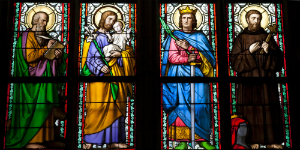Fewer blind people use Braille
FREE Catholic Classes
Chicago Tribune (MCT) - Justin Egle was born at 23 weeks, before his retinas had a chance to fully develop, leaving him totally blind.
Highlights
McClatchy Newspapers (www.mctdirect.com)
4/17/2009 (1 decade ago)
Published in Health
Now 13, the Glenview, Ill., boy has fallen behind academically _ and his mother believes it's because he hasn't received adequate Braille training. His school offers him 40 minutes of Braille instruction four days a week.
"They have mislabeled him as retarded, but the problem isn't that he can't learn ... it's that he never got the skills needed to be a good reader. I constantly ran into roadblocks," said Tina Egle, who now takes her son to a private Braille tutor.
By all accounts, Justin Egle's experience is not unusual. Fewer than 10 percent of the 1.3 million legally blind Americans read Braille, the system of raised dots that has represented the alphabet to the visually impaired for almost two centuries. Moreover, just 10 percent of children are learning the system compared to more than 50 percent during its heyday in the 1950s, according to a recent report by the National Federation for the Blind.
"Either people aren't learning it, they don't have access to it, or they just don't have enough faith in it," said Chris Danielsen, representative for the Baltimore-based group.
The report ticks off a multitude of reasons why Braille is in decline, from a shortage of qualified teachers to mainstreaming in money-strapped schools to parents who discourage kids from learning it in favor of voice-recognition software, audio-texts and other technology. One point is clear: Without Braille literacy, the chances of pursuing higher education and better-paying jobs are greatly reduced, advocates say. Even before the recession, the unemployment rate among blind adults hovered around 70 percent.
"I challenge anyone to learn geometry from an audio text," said Barbara Perkis, director of the Illinois Instructional Materials Center at the Chicago Lighthouse on the city's near West Side.
The 125,000-volume collection furnishes textbooks for any visually impaired student in the state and has served as a national model since its inception in 1965.
While Perkis doesn't see Braille vanishing any time soon, she laments the gaps in instruction for many of the state's 3,600 visually-impaired students.
While there are some "amazingly dedicated" teachers, they frequently must shuttle long distances between school districts and are only available at certain times, making scheduling a tricky proposition.
"Consistency can be a real problem," she acknowledged.
Bias and low expectations are issues, too, said Patti Gregory-Chang, 45, who started losing her sight at age 12 because of a degenerative eye condition. Teachers tend to steer people like her, who have some residual vision, toward large print rather than this essential tool, said the Chicago lawyer.
"It's the Braille that got me through law school and it's Braille that I use in court, but teachers see any kind of vision as better (than using Braille)," she explained. "What kind of message does that send to kids?"
In an earlier era, many blind youth attended residential institutions, which often immersed them in Braille. But in 1974, the federal law changed and students with disabilities of all kinds were guaranteed public education in the least restrictive environment _ often a neighborhood school, where parents and staff may be at odds over what will optimally prepare the child for the future.
Convinced that Justin, who is also autistic, wasn't receiving enough instruction, Egle ultimately decided to find private Braille tutoring.
"Without Braille, he will always be dependent on other people ... he'll always be a second-class citizen," she said.
Due to confidentiality, North Suburban Special Education District _ which serves 40 visually impaired students, including Justin _ said it cannot comment on instruction provided for an individual child.
For those who live outside urban areas, access to any kind of Braille instruction can be an obstacle.
Beth Sturman has been frustrated in efforts to get her 12-year-old son's reading fluency to age-level in Downstate Collinsville, Ill. He was born blind in one eye with 20/400 vision in the other.
"Never once did his vision teacher suggest Braille," said Sturman, a special education teacher.
Traveling to Chicago isn't an option, and the district won't pay for services in St. Louis, just across the river, because it's out of state.
Then there's the problem of kids wanting to fit in.
"Kids don't want to be different ... and technology just looks cooler than Braille," said Ray Campbell, who works at the Lighthouse and is president of the Illinois Council of the Blind. His fingers fly across the embossed dots at 122-words-per minute.
At 44, he is young enough to empathize with youngsters _ but he also knows their life without the skill will be more difficult. "And that makes me very sad," he said.
To help promote Braille literacy, the U.S. Mint last month launched the nation's first coin with readable Braille. On one side of the silver dollar is a portrait of Louis Braille, who invented the tactile code as a teen.
The coin, which celebrates his 200th birthday, costs about $32 and can be ordered through the mint (www.usmint.gov). Proceeds will help fund a national campaign to double the number of visually impaired children learning Braille by 2015, said Danielsen.
Adnana Saric, a senior at Walter Payton High School, is doing her part to raise Braille's profile. She recently competed in the Illinois Braille Challenge and hopes to qualify for the nationals in Los Angeles this summer before attending Loyola University in the fall.
"I wouldn't be at this point without Braille," Saric said.
"If you rely on audio, it takes something away. Reading is such a pleasure...There is no substitute for having the book in front of you."
___
© 2009, Chicago Tribune.
Join the Movement
When you sign up below, you don't just join an email list - you're joining an entire movement for Free world class Catholic education.
-

-
Mysteries of the Rosary
-
St. Faustina Kowalska
-
Litany of the Blessed Virgin Mary
-
Saint of the Day for Wednesday, Oct 4th, 2023
-
Popular Saints
-
St. Francis of Assisi
-
Bible
-
Female / Women Saints
-
7 Morning Prayers you need to get your day started with God
-
Litany of the Blessed Virgin Mary
Daily Catholic
 Daily Readings for Saturday, November 02, 2024
Daily Readings for Saturday, November 02, 2024 St. Victorinus of Pettau: Saint of the Day for Saturday, November 02, 2024
St. Victorinus of Pettau: Saint of the Day for Saturday, November 02, 2024 Daily Prayer For The Holy Souls: Prayer of the Day for Saturday, November 02, 2024
Daily Prayer For The Holy Souls: Prayer of the Day for Saturday, November 02, 2024- Daily Readings for Friday, November 01, 2024
- St. Valentine Berrio-Ochoa: Saint of the Day for Friday, November 01, 2024
- Litany of the Saints: Prayer of the Day for Friday, November 01, 2024
![]()
Copyright 2024 Catholic Online. All materials contained on this site, whether written, audible or visual are the exclusive property of Catholic Online and are protected under U.S. and International copyright laws, © Copyright 2024 Catholic Online. Any unauthorized use, without prior written consent of Catholic Online is strictly forbidden and prohibited.
Catholic Online is a Project of Your Catholic Voice Foundation, a Not-for-Profit Corporation. Your Catholic Voice Foundation has been granted a recognition of tax exemption under Section 501(c)(3) of the Internal Revenue Code. Federal Tax Identification Number: 81-0596847. Your gift is tax-deductible as allowed by law.







 Daily Readings for Saturday, November 02, 2024
Daily Readings for Saturday, November 02, 2024 St. Victorinus of Pettau: Saint of the Day for Saturday, November 02, 2024
St. Victorinus of Pettau: Saint of the Day for Saturday, November 02, 2024 Daily Prayer For The Holy Souls: Prayer of the Day for Saturday, November 02, 2024
Daily Prayer For The Holy Souls: Prayer of the Day for Saturday, November 02, 2024


